
PG&E’s decision to cut power last month (and possibly again this week) to hundreds of thousands of customers has thrown Northern California into disarray. Yet despite the blackouts, fires still raged, with people evacuating and in some cases losing homes.
How did California end up in this situation? Who was most affected by the power shut-offs, and what can be done to keep the lights on in the future?
We’ll discuss on City Visions tonight at 7pm, with guests:
- Nick Chaset, Chief Executive Officer of East Bay Community Energy;
- Martha Guzman Aceves, Commissioner at the California Public Utilities Commission; and
- Michael Wara, Director of the Climate and Energy Policy Program at the Stanford Woods Institute for the Environment.
Tune in at 7pm at 91.7 FM in the San Francisco Bay Area or stream live. Call 866-798-TALK (8255) with questions or email us at cityvisions@kalw.org!
Good news on California’s efforts to fight climate change: in-state emissions in 2017 (the latest available data) were down over 2016 and ahead of the state’s mandatory 2020 goals. The California Air Resources Board announced the progress yesterday, with this chart showing emissions in context of population and GDP:
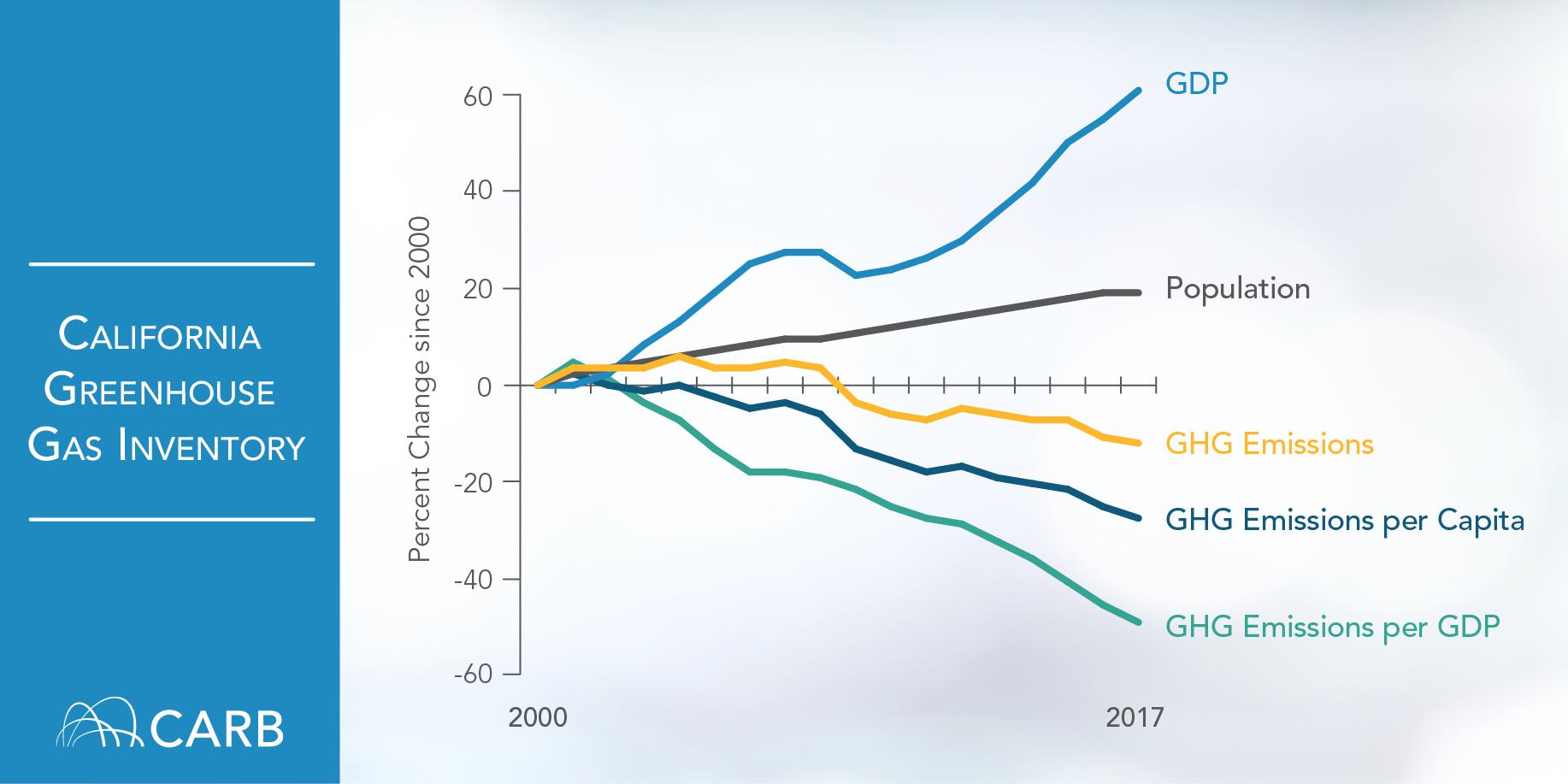
Overall, emissions totaled 424 million metric tons of carbon dioxide equivalent in 2017, down 5 million metric tons from 2016. For reference, the 2020 reduction target is 431 million metric tons.
Most of the progress came from the electricity sector, where for the first time renewable sources made up a larger percentage of the generation than fossil fuels.
However, transportation emissions increased 0.7% in 2017, compared to a 2% increase in 2016, mostly from passenger vehicles. That total is even worse when you consider pollution from oil and gas refineries that make the fuel for these passenger vehicles. Together with hydrogen production, these sources constituted one-third of the state’s total industrial pollution.
Here’s the latest pie chart on where the emissions came from in 2017:
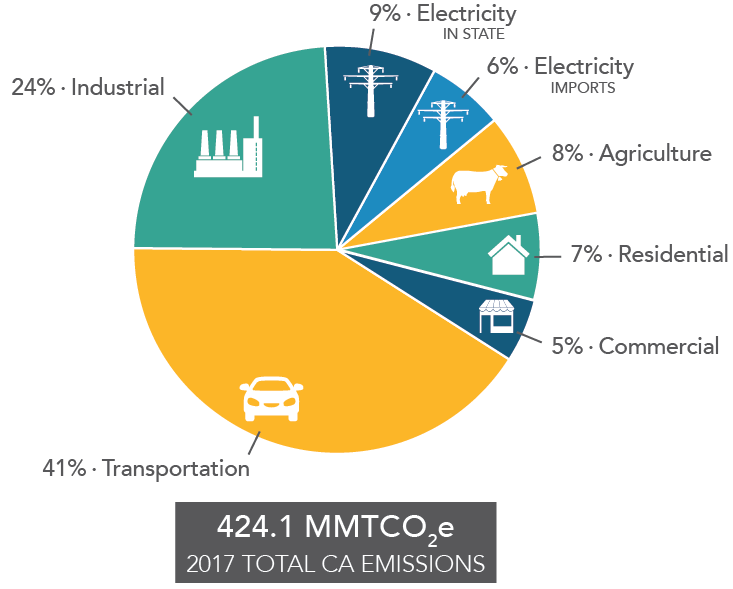
While the story is overall positive for California’s climate efforts, the state will have to redouble its efforts to reduce driving miles by allowing more homes to be built near jobs and transit, while transitioning the remaining driving miles to zero-emission technologies like electric vehicles.
Los Angeles mayor Eric Garcetti made headlines recently by unveiling the city’s version of a “Green New Deal,” complete with ambitious goals to create a zero-emission transportation network, a zero-carbon electricity grid, and a Los Angeles that “won’t send a single piece of trash” to the landfill by 2050.
The goals in the new sustainability plan [PDF] are necessary to meet our environmental and sustainability needs, but how can the city make them feasible to achieve?
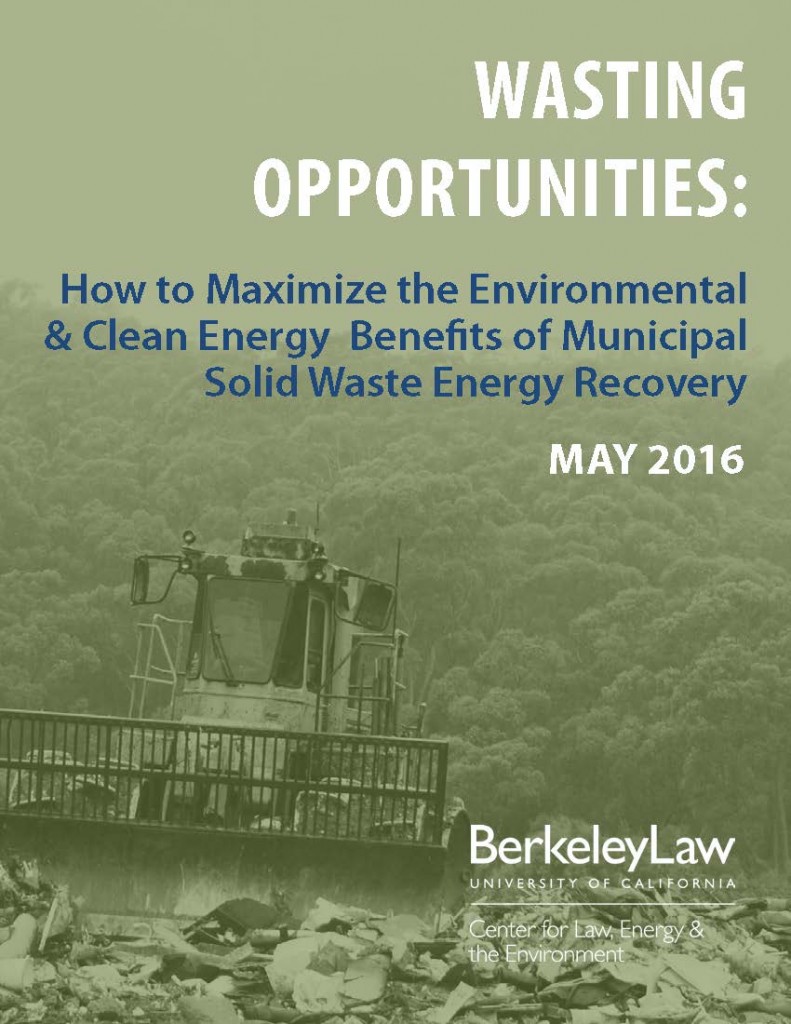
I discussed the zero-waste goal in particular on KPCC radio’s AirTalk program, along with my UCLA Law colleague Cara Horowitz. My comments were drawn largely from the 2016 CLEE report “Wasting Opportunities” on boosting energy recovery from municipal solid waste to meet climate goals.
The bottom line? Achieving zero waste will require significant reduction of materials in use, increases in recycling and composting, and — yes — some type of energy recovery from whatever is left over. You can listen to the broadcast here.
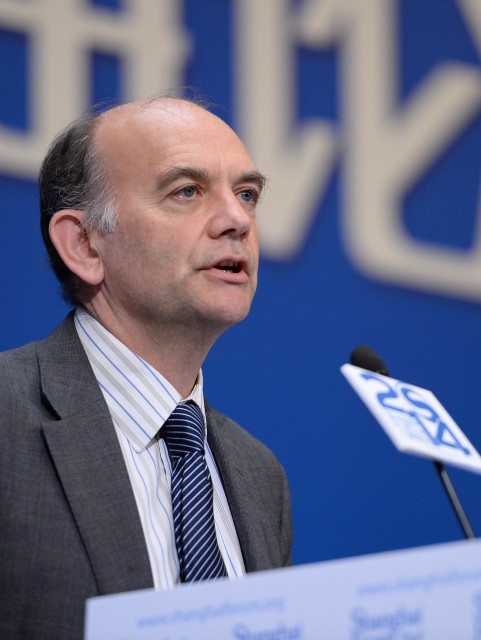
For those in the Bay Area, Berkeley Law’s Center for Law, Energy and the Environment (CLEE) will be hosting a free brown bag lunch talk today with Prof. Michael Grubb, professor of Energy and Climate Change at the University College of London.
Professor Grubb has been at the forefront of the United Kingdom’s successful-to-date effort to reduce carbon emissions from its electricity sector. In a talk entitled “Innovation, economics and policy in the energy revolution: Insights from the UK electricity transition and wider implications,” Dr. Grubb will describe how this transition occurred.
The event will run from 12:50 to 2pm in Boalt Room 10. More info and RSVP here. Hope to see you there!
I’ll be a guest on KPCC radio’s AirTalk program today at 10:20am, discussing the decision by the Los Angeles Department of Water and Power, at the urging of Mayor Garcetti, to phase out natural gas plants along the coast rather than rebuild them.
The plants will be replaced by renewable energy sources and energy storage, among other clean resources. Some business groups are concerned about the economic impacts on ratepayers, including the other guest, Stuart Waldman, president of the Valley Industry and Commerce Association.
It should be a lively discussion, so I hope you can tune in and ask questions!
Biofuels could offer an important solution for reducing greenhouse gas emissions from the transportation sector. Depending on the plant (or grease) feedstock, they can blend in with existing fuel or serve as separate liquid fuels to power airplanes, long-distance trucks, and other vehicles.
Today on Your Call on KALW 91.7 FM in San Francisco, we’ll discuss the prospects for more low-carbon biofuel deployment, as well as the potential carbon downside of some types of biofuels. Joining me will be:
- Daniel Kammen, Professor of Energy at the University of California, Berkeley, with parallel appointments in the Energy and Resources Group, where he serves as Chair of the Goldman School of Public Policy and directs the Center for Environmental Policy, and the department of Nuclear Engineering.
- Dr. Jeremy Martin, Senior Scientist and Director of Fuels Policy at Union of Concerned Scientists, where he evaluates the impact of biofuels and fuel policy.
You can stream it live or listen to 91.7 FM in San Francisco. Call in with questions or comments!
Pacific Gas & Electric, California’s largest investor-owned utility is about to declare bankruptcy, which could undermine the state’s climate goals. The utility faces massive liability for potentially causing the recent devastating Northern California wildfires.
If bankruptcy happens, California’s clean energy companies — from solar PV facilities to energy efficiency contractors to electric vehicle charging businesses — could soon lose one of their top customers and potentially see their existing contracts ripped up. And that means the state is losing a major investor in various climate programs.
Buzzfeed and E&E News [paywalled] covered this story in more detail, including some quotes from me.
Going forward, I hope the state and various local governments in PG&E service territory consider the following reforms:
- Break up PG&E’s electricity and gas divisions, with the long-term goal of phasing out natural gas use in the state. We mostly likely need to accomplish this phase-out anyway and move towards all-electric appliances and building. A breakup could hasten that progress.
- Buy out PG&Es assets and form municipal utilities. San Francisco is already exploring purchasing the “sticks and wires” in the city to form its own utility. Municipal utilities in the state tend to have cheaper rates and often more aggressive clean energy policies (such as Sacramento Municipal Utility District), so this could be a good move overall for ratepayers and the environment. Although it’s worth noting that PG&E is one of the cleanest utilities in California already.
- Revamp liability for wildfires going forward. Right now, whichever party is responsible for igniting a blaze is 100% liable for all damages. But what about property owners who failed to maintain and “fire-harden” their buildings? What about local officials that allow development in high-risk fire zones? What about polluting companies that caused climate change, which exacerbated the fires’ intensity? Liability should fall on these parties, too, giving them incentive to correct their actions going forward and hopefully reduce the severity of future wildfires.
These reforms would be a welcome outcome from an otherwise unfortunate situation. In the meantime though, it’s hard to foresee an outcome of PG&E’s death spiral that won’t at least temporarily slow our climate progress in California.
As 2018 nears its end, here are my Top 6 developments in climate & energy policy this year:
-
- Worldwide greenhouse gas emissions increase. Let’s start with the bad news for 2018: emissions are rising like a “speeding freight train,” primarily due to more coal-fired power coming on line for India and China, plus more energy use in the United States. Emissions are expected to increase 2.7 percent in 2018, according to research published by the Global Carbon Project. Meanwhile, a U.N. report in October indicated that the world may have just about a dozen more years to get emissions under control enough to avert disastrous warming. These reports should be concerning to everyone.
- Solar PV hits policy and deployment bumps but with long-term growth potential. With declining policy support worldwide, including costly tariffs on solar PV in the U.S., solar PV leaders have seen a downturn in 2018, for the first time in recent memory. Globally, according to the Frost & Sullivan (F&S) report Global Renewable Energy Outlook, 2018, the world saw 90 gigawatts (GW) of new solar installations for 2018, which was a slight year-on-year decrease. Overall though, renewable capacity will see 13.3% annual growth in 2018. The report authors expect global investment in renewable energy for the year to be $228.3 billion, a slight increase of 0.7% over 2017. In the U.S., according to latest industry figures, the third quarter saw installed solar PV capacity experience a 15% year-over-year decrease and a 20% quarter-over-quarter decrease. However, total installed U.S. solar PV capacity is expected to more than double over the next five years. Overall, the picture is concerning but with a potentially positive long-term outlook.
- EV sales increase worldwide, with 1 million in the U.S. and the Tesla Model 3 finally unveiled. The chart below tells the largely encouraging story:
 China leads the pack with 40% of all sales. Here in California, sales just reached half a million, with one million nationwide. Prices continue to fall, and the Tesla Model 3 became the #6 top-selling car in the U.S. in November. Of all the climate change news, this progress on vehicle electrification may be the most hopeful, although we’ll need to see even more rapid deployment over the next decade to get growing worldwide transportation emissions under control.
China leads the pack with 40% of all sales. Here in California, sales just reached half a million, with one million nationwide. Prices continue to fall, and the Tesla Model 3 became the #6 top-selling car in the U.S. in November. Of all the climate change news, this progress on vehicle electrification may be the most hopeful, although we’ll need to see even more rapid deployment over the next decade to get growing worldwide transportation emissions under control. - Electrification of transportation spreads to trucks, buses and scooters. The EV revolution has spread, with cheaper, more powerful batteries now making electric “micromobility” options feasible, such as e-bikes and e-scooters. 2018 was truly the year of the e-scooter, when it comes to city streets. And on the heavy-duty side, companies are unveiling previously unheard of electric models, such as Daimler Trucks North America making the first delivery of an all-electric delivery truck, the Freightliner eCascadia, while the California Air Resources Board last week enacted a new rule requiring transit buses to be all-electric by 2040. All told, it’s a positive development for low-carbon transportation.
- Movement to legalize apartments near transit in California and across the U.S. All the electrification we can muster on transportation won’t matter much if we don’t decrease overall driving miles. It’s a particular problem in the U.S., with so many of our major cities built around solo vehicle trips. So it was encouraging to see California attempt to legalize apartments near major transit with Scott Wiener’s failed SB 827 earlier this year (which started a productive conversation) and now a potentially viable version in SB 50. The movement is catching on around the country, as Minneapolis just voted to end single-family zoning. It’s long overdue and our only real hope to decrease driving miles.
- Trump rollback proposals increase but face judicial setbacks. Trump’s attack on environmental protections made news all year, particularly his attempted rollback of clean vehicle fuel economy standards. The only bright spot is that many of his regulatory rollbacks are sloppy and getting shot down in the courts, as my colleague Dan Farber noted in a report and recent Legal Planet post. And with Democrats set to control the House of Representatives next month, pro-environment legislators are set to have more negotiating power on everything from the budget to enforcement to policy oversight.
So the trends overall are uneven, with a lot for concern and also promising technology and policy momentum still in effect. 2019 could also greatly change this picture, with a potentially slowing economy and more private sector innovation on clean technology.
Overall, those who care about these issues have a lot to digest and ponder this holiday season, along with the cookies. See you in 2019!
California has officially launched its “net zero” requirements for new homes, which will mandate rooftop solar or the equivalent for new residential construction. Marketplace on NPR covered the story, including an interview with me:
As I blogged previously, the edict comes not without controversy, particularly from economists convinced that utility-scale solar PV is more cost-effective than the rooftop, distributed type. Still, the mandate has flexibility along these lines and promotes other cost-effective forms of distributed energy, such as community solar and on-site energy storage.
And as California pioneers this approach, we’ll soon have data on how effective it will be, potentially as a model (or lesson) for other jurisdictions contemplating the adoption of similar programs.
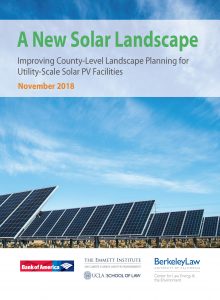 UC Berkeley and UCLA Schools of Law are today releasing a new report, A New Solar Landscape, which identifies key reforms for California to enact at the state, regional, and local level to increase the pace and optimal siting of utility-scale solar photovoltaic (PV) development. With the passage of SB 100 (de León, 2018), California now requires electric utilities to obtain 60 percent of their electricity from renewable sources by 2030 and 100% carbon-free electricity by 2045. To meet these goals, the report recommends that state leaders:
UC Berkeley and UCLA Schools of Law are today releasing a new report, A New Solar Landscape, which identifies key reforms for California to enact at the state, regional, and local level to increase the pace and optimal siting of utility-scale solar photovoltaic (PV) development. With the passage of SB 100 (de León, 2018), California now requires electric utilities to obtain 60 percent of their electricity from renewable sources by 2030 and 100% carbon-free electricity by 2045. To meet these goals, the report recommends that state leaders:
- Encourage development of county-level landscape plans by linking them to incentives like expedited review under the California Environmental Quality Act.
- Ensure that project benefits flow first to communities most immediately affected by development.
- Increase support for transmission infrastructure located in areas appropriate for solar development.
- Create a consolidated, statewide zoning and planning data resource.
The report is sponsored by Bank of America and informed by two expert stakeholder convenings facilitated by the law schools.
Utility-scale solar PV facilities—large panel arrays that generate power to sell into the electrical grid—are the most economical method of delivering the large quantities of power needed to satisfy California’s renewables portfolio standard (RPS). Solar energy is the most significant source of renewable energy in California, accounting for over one-third of all renewable power generated in 2017, and well over half of total generating capacity. As solar prices continue to fall, many experts agree that solar will play an even greater role in California’s achievement of future renewables targets, potentially constituting up to 95 percent of new generation.
But these projects, often located in rural areas, can face significant barriers to obtaining the local approvals necessary to begin development, potentially hindering climate progress. To address issues such as a lack of local buy-in to proposed projects and a lack of coordination among local and state planners, the report proposes policies such as:
- Quantifying the total amount of land needed for solar PV facilities in order to meet the state’s climate goals, and communicating this information to local communities where the facilities might be located;
- Preparing solar PV permitting guidebooks that clarify local requirements for developers and help residents understand the process;
- Increasing coordination between state and utility electrical transmission planners and local governments responsible for project approvals; and
- Encouraging community benefit agreements that guarantee local benefits in connection with new solar PV developments.
These recommendations, among many others described in A New Solar Landscape, can help California’s policymakers, local governments, and solar industry leaders develop a county-level landscape planning system that accounts for and promotes state renewable energy targets, environmental conservation and land preservation goals, and community development needs.
For more details, download the report here.


